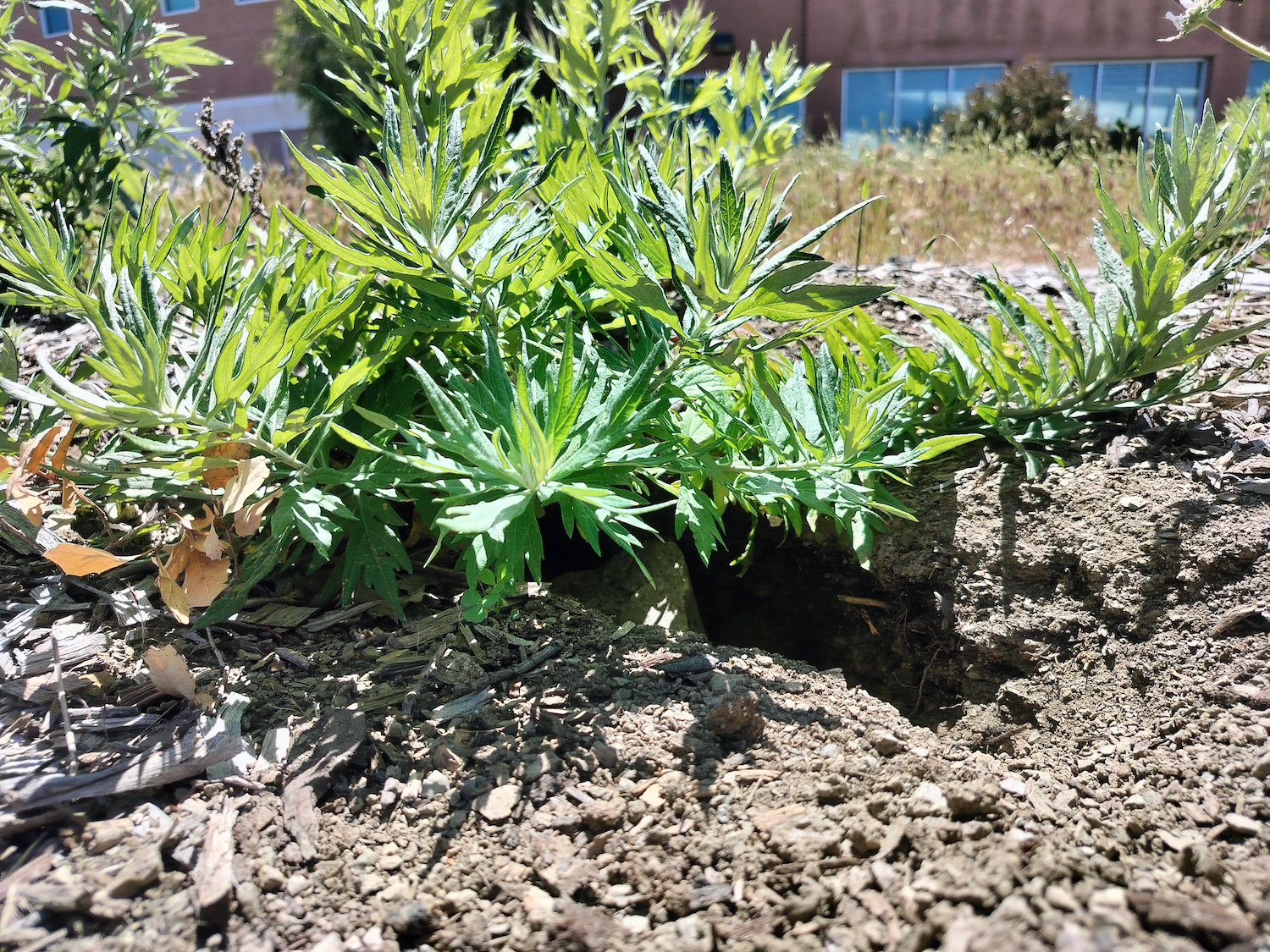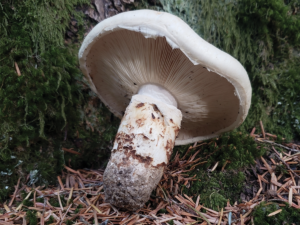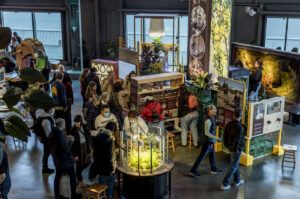When Cafe Ohlone cofounders Vincent Medina and Louis Trevino first visited the proposed garden site at California State University East Bay’s satellite campus in Concord, they felt the importance of the place. From it they could see Mount Diablo—ṭuuštak in Chochenyo—the center of Ohlone creation, abloom with wildflowers and studded with oak trees.
Now, thanks to a $900,000 grant from the U.S. Environmental Protection Agency, Medina and Trevino are helping transform this space into an Indigenous community garden and gathering place, for stewardship and storytelling—and to improve the ecosystem on campus for wildlife and students alike. The EPA awarded the money to the university from its San Francisco Bay Water Quality Improvement Fund, a grant pool that’s been bolstered by the Bipartisan Infrastructure Law. Medina and Trevino’s mak-‘amham/Cafe Ohlone, a Berkeley-based restaurant and community space for Ohlone people, is a subawardee.
The garden isn’t Land Back—it isn’t being transferred to Indigenous control. But it is nonetheless part of a growing movement to center Indigenous leadership and land stewardship, in a region where lack of federal tribal recognition and a difficult land market has made repatriation a rarity. Gardens built by and for Indigenous people have been popping up around the region, including one at the soon-to-open Dos Rios Ranch State Park near Modesto, and another in San Francisco that is getting $500,000 in Inflation Reduction Act funding through the EPA.

About this project: Bay Nature is reporting on funding for nature in BIL and IRA. Tell us what you think or send us a tip at wildbillions@baynature.org, and read more at our Wild Billions project page.
Medina sees places like the Concord Center garden as “touchstones”—“places where we see ourselves,” Medina says. “Whether or not the land and title is directly given back to us Ohlones.” He says work on the garden, in partnership with the university, has been a step in the right direction. “Each meeting has built up immensely positive feelings, and we’ve seen them listen to—again and again—Ohlone leadership,” Medina says. “It’s a really good example of positive change happening in front of our eyes.”
Kathy Cutting, campus support coordinator for the Concord center, began working on this project with a modest $50,000 grant back in 2022. She wanted to facilitate Indigenous land stewardship on campus. Now, she says, “my goal is to get it so well-entrenched in the community that it’s a no-brainer to take it to the next step.”

The Concord campus is both desert and oasis. It’s 30 minutes from the closest bus stop, and the only dining option is a row of vending machines. At the same time, 324 of its 384 acres are open space, encompassing grassy hills that roll down toward Galindo Creek, which flows from Mount Diablo down to the Bay.
The grant seeks to bridge the gap by working the land to provide fresh food for the community. “We have students with food insecurity,” says Kate Shade, an assistant professor of nursing at CSU State who is the principal investigator on the grant.
Sign up today!

The garden is taking root. Under the shade of a valley oak tree, saplings of native perennials like dogbane and yarrow rise slowly from soft patches of bark mulch. Nearby, hundreds of small plants wait to be planted—some seedlings, some already fruiting lemon trees. The tags identify the garden’s soon-to-be inhabitants: elderberry, black sage, dogbane. Cafe Ohlone provided a plant list, after consulting their elders, and plans to provide educational materials to enrich the garden, like the plants’ Chochenyo names and stories about their significance. Cutting’s team helped prioritize plants on the list that were most likely to thrive in Concord’s heat. All the plants will, ideally, bear some kind of edible treat. Some are recognizable: lemons and acorns, for example. “But most people would just walk by some of the plants and not recognize it as a food source,” Cutting adds. What surprised her the most were the wild grasses, whose seedheads can be cultivated and ground for their oils.
First pickings will go to Cafe Ohlone, which serves traditional Ohlone cuisine. Medina says they often have a difficult time finding locally sourced ingredients like tarweed and brodiaea potatoes, the edible bulbs of a purple wildflower. Indigenous people will also be able to gather food, as will students and community members.



Clockwise from left: A dogbane sprout grows in front of a Concord campus building; Seedlings are kept in small containers before they are planted into the garden; Mesh wiring and other materials for the garden are ready to go. (Anushuya Thapa)
News of a native plant garden—especially one with significant federal funding—travels fast. Neighbors have already emailed Cutting, asking how they can be of service. One happens to lead a nearby plant nursery, which has provided many tree saplings. Students have been helping plant trees. The more people that get involved, the better, Cutting says. The grant provides funding for three research assistant positions each semester, for the four years that the grant is active. Some of the money will even go toward transportation shuttles, to get students from CSU’s other East Bay campuses over to the Concord site. “Come in here and get interested,” Cutting says. “And hopefully, get your hands dirty.”
Working with tribal partners has been a learning experience for Cutting and Shade. One example Cutting cites: a time-scale difference. Cutting wants to get the project self-sufficient before she retires soon. But her Indigenous partners, she says, think of the land as something they’ll invest in “long after these buildings erode and collapse back to the ground”—and therefore take time with their deliberations, consulting with community elders first.
Cutting and Shade have also gotten used to sharing their space with its nonhuman inhabitants. On an April visit, piles of dirt from gophers lay clumped nearby freshly planted yarrow. “Those yarrow are probably going to be gone in the next week,” Cutting says. One sage bush has had the soil under it hollowed out by a ground squirrel. But she says she’s learned, from her Indigenous partners, to “just plant more. Share. Share.” And instead of hunting down the gophers and squirrels, the team’s been installing owl boxes.
This is a garden that’s unlikely to contain neat row crops. It’ll be more of a food forest, Shade says. Native plants will be intermixed with fruit trees, and planted in stone-hemmed guilds instead of boxes. Cutting says she hesitates to even call the project a “community garden”—she wants the focus to be on land stewardship more broadly: the grant includes money for wildlife monitoring, too.

The team’s vision for the grant is broad. Where the oak trees now grow along Galindo Creek, they envision a meeting space for Indigenous people. They imagine the neighborhood overlooking the creek as engaged stewards, too. Cutting hopes these two groups will be the ones that are the most engaged with the project. “Because it’s certainly not mine,” she says, of the land. “My intention is that this is for them, for as long as they want to use it.”
In the fall, Medina and Trevino have plans to bring in an Ohlone cultural burn leader from further south along the coast to perform an inaugural burn on a patch of land leading into the garden. What begins then, they hope, will continue to be a part of their community for generations to come. “On a nice warm night,” Medina says, “Our East Bay Ohlone people will see our elders comfortably sitting there, at the foot of Mount Diablo, where our world was created.”
Update, May 10, 2024: A photo caption has been corrected to identify the plant above a ground squirrel tunnel as mugwort. The story has been updated to use a modern spelling of Mount Diablo’s Chochenyo name, and to refer to the mountain as the center of Ohlone creation (not creation myths).




